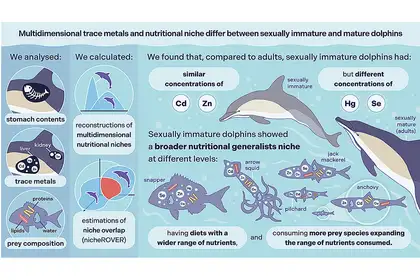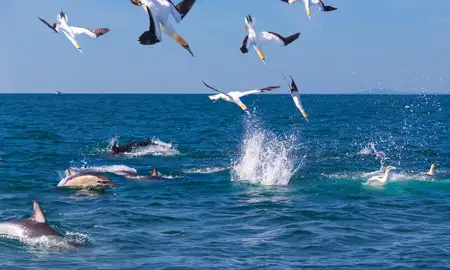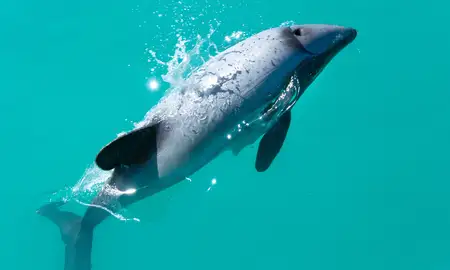
Graphical abstract for Stockin et al (2023) by Science Graphics Design.
A new study examining the complex interactions between trace metals and the nutritional niche of dolphins has revealed surprising insights into how sexual maturity affects the protein and lipid uptake in dolphins, but also how it affects the ingestion of trace elements.
The Massey University-led study assessed common dolphins over a three-year period to determine whether sex, age and sexual maturity status affects the nutritional quality of prey species eaten by dolphins.
A multidisciplinary approach of stomach content, trace element and prey composition analyses was used to reconstruct the nutritional niches of sexually mature and immature animals examined post mortem. The research team used this approach to determined what degree of niche overlap exists between different life history stages, and what that meant not only for the nutritional update of proteins and lipids, but also what impact that had on measured trace element concentrations accumulated in the liver and kidney of dolphins.
The study, published this week in the international journal Environmental Pollution, revealed how sexually immature dolphins showed a higher degree of prey and nutrient generalism compared to mature conspecifics (members of the same species).
Professor Karen Stockin of the School of Natural Sciences says, “While immature dolphins show a higher degree of prey and nutrient generalism compared to their mature conspecifics, a low niche overlap offered first insights to the differing pathways in which dolphins of different life stages ingest copper, zinc, cadmium and mercury.”
Study co-author Dr Gabriel Machovsky-Capuska of Nutri-Lens says, “These findings have particular relevance when addressing how marine pollution and climate change may influence nutritional and trace metal pathways and therefore, the nutritional requirements and potential fitness of marine predators in the wild.”
Related news
A nutritional perspective on dolphin-gannet relationships reveals new insights into joint feeding
New research reveals some fascinating insights into the age-old relationship between Australasia gannets and common dolphins.

First insights into potential competition between New Zealand’s toothed whales and dolphins
New research using stable isotopes has shed light on how New Zealand’s diverse range of toothed whales and dolphins coexist.

What’s for dinner? State of Hauraki Gulf reflected in dolphin diet
Evidence has emerged to support stricter coastal management, this time focusing on pollution and overfishing.
